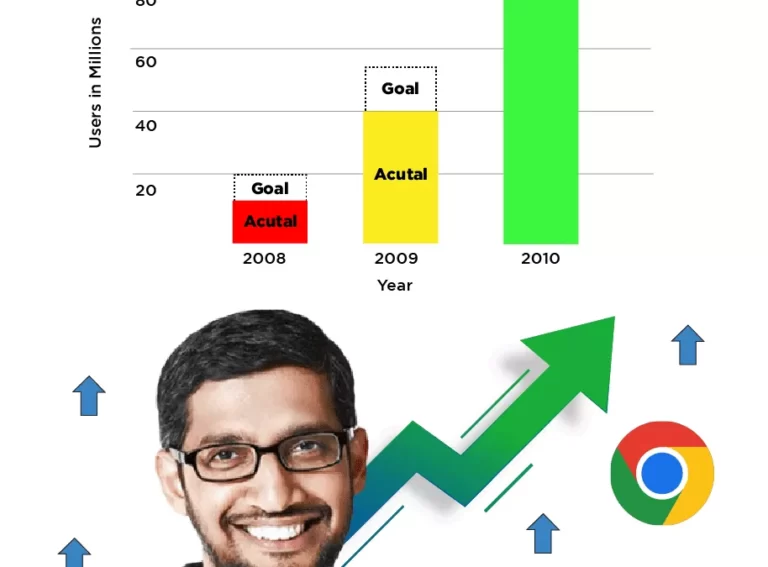Do you know, what helped Googler Sundar Pichai to build the best browser in the world?

OKRs, which stands for Objectives and Key Results, is a goal-setting framework used by many companies, including Google. The OKR framework involves setting specific, measurable, and ambitious objectives aligned with the company’s overall mission. These objectives are then broken down into key results, which are measurable outcomes that help to track progress toward achieving the objectives.
Google Chrome is one of the most popular web browsers in the world, with over 60% market share as of early 2021. Google launched the browser in 2008, and it has since become known for its speed, simplicity, and security.
But how did Google manage to build such a successful product? One key factor is the use of OKRs.
In 2008, a Googler, Sundar Pichai, took on an objective, which was to build the best web browser.
He was very thoughtful about how he chose his key results. 20 million users, that was his clear key result, he was very clear that users are going to decide whether it’s the best browser or not.
His 3-year-long objective was “Build the best browser”.
And every year he stuck with the same key results –
In the first year, the key result was 20 million users, he missed it, and he got less than 10 million users.
In the second year, he raised the bar to 50 million; he got 37 million users.
In the third year, he up the bar to 100 million users, launched an aggressive marketing campaign, and broader distribution, improved the technology, he got 111 million users.
Here’s how Google used OKRs to build Google Chrome:
Setting Clear Objectives: The first step in using OKRs is to set clear objectives. One of the most significant benefits of using OKRs is that they help to set clear objectives for a project. By having clear objectives, the team was able to focus on the most important features and functionalities needed to achieve these objectives.
For Google Chrome, the primary objective was to create a web browser that was faster, more reliable, and more user-friendly than existing browsers. This objective was aligned with Google’s mission to organize the world’s information and make it universally accessible and useful.
Measuring Progress: OKRs also help to measure progress towards achieving objectives. By tracking progress, the team could quickly identify areas that needed improvement and adjust accordingly.
Once the objectives were established, Google defined measurable key results that would help track progress toward achieving them. For example, key results might include metrics such as the number of users, page load times, browser startup time, number of crashes, user satisfaction ratings, and market share. By setting specific, measurable goals, the Google Chrome team could measure their progress and make data-driven decisions.
Alignment with Company Mission: OKRs also help to ensure that projects are aligned with the overall mission of the company. Google’s mission is to organize the world’s information and make it universally accessible and useful. By setting objectives that align with this mission, the team building Chrome was able to ensure that the browser would contribute to Google’s overall goals.
Continuous Feedback and Adjustments: One of the key benefits of the OKR framework is that it promotes continuous feedback and adjustments. The Google Chrome team regularly reviewed their progress toward their objectives and key results and adjusted as needed. For example, if page load times were slower than expected, the team might prioritize performance improvements in the next development cycle.
Cross-Functional Collaboration: Another benefit of the OKR framework is that it encourages cross-functional collaboration. The Google Chrome team was made up of engineers, designers, product managers, and many other roles. By using OKRs, everyone on the team had a clear understanding of the overall objectives and how their individual work contributed to them. This alignment helped the team work more efficiently and effectively towards a common goal.
Emphasizing User Experience: Finally, Google Chrome’s success can be attributed in part to its focus on user experience. The OKR framework helped the Google Chrome team keep the user in mind throughout the development process. For example, by tracking user satisfaction ratings as a key result, the team was able to measure the impact of new features and improvements on the user experience.
In conclusion, Google used OKRs to help build Google Chrome as the world’s most popular web browser. By setting clear objectives, defining measurable key results, promoting continuous feedback and adjustments, encouraging cross-functional collaboration, and emphasizing user experience, the Google Chrome team was able to create a browser that has revolutionized the web browsing experience.
Overall, OKRs and OKR management software can be incredibly beneficial for companies, including Google, in achieving their goals.
We at Vizual offer a stunning Enterprise SaaS-based online dedicated tool called ‘VizualPro Suite.’ VizualPro Suite is one of the best OKR and Task Management software. VizualPro Suite is one of the best systems to align OKRs with Task Management. It supports setting objective key results, OKR tracking, employee performance management, and task management/ automation capabilities.
The suite helps set, communicate, track, and measure Objectives, key results, and linked tasks within businesses. Our specialists created the VizualPro Suite solution using the “Design Thinking” process to produce the best results for the strategic future. We help you in rolling out our OKRs successfully in your organization. Please contact us today!
The benefits of this system are many – Improved alignment, Increased productivity, better collaboration, Enhanced accountability, Greater visibility, and more.
Please get in touch with us for a free demo. Visit http://www.vizualplatform.com/.
Join Our Newsletter
